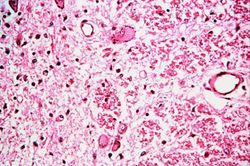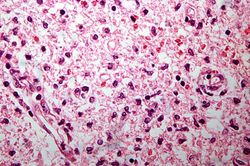Difference between revisions of "IPLab:Lab 8:Poliomyelitis"
Seung Park (talk | contribs) (→Related IPLab Cases) |
Seung Park (talk | contribs) (→Clinical Summary) |
||
| Line 1: | Line 1: | ||
== Clinical Summary == | == Clinical Summary == | ||
| − | Six days before his death, this 31-year-old white male became acutely ill with fever followed by an ascending paralysis which began in his feet. Three days later he was hospitalized because of difficulty in breathing. A lumbar puncture was performed and the patient's spinal fluid contained increased protein and polymorphonuclear leukocytes (4.30 PMNs/ | + | Six days before his death, this 31-year-old white male became acutely ill with fever followed by an ascending paralysis which began in his feet. Three days later he was hospitalized because of difficulty in breathing. A lumbar puncture was performed and the patient's spinal fluid contained increased protein and polymorphonuclear leukocytes (4.30 PMNs/mm³). He died on the third hospital day. |
== Autopsy Findings == | == Autopsy Findings == | ||
Revision as of 00:51, 26 August 2013
Contents
Clinical Summary[edit]
Six days before his death, this 31-year-old white male became acutely ill with fever followed by an ascending paralysis which began in his feet. Three days later he was hospitalized because of difficulty in breathing. A lumbar puncture was performed and the patient's spinal fluid contained increased protein and polymorphonuclear leukocytes (4.30 PMNs/mm³). He died on the third hospital day.
Autopsy Findings[edit]
At autopsy, the thoracic and lumbar portions of the spinal cord were softer than normal and focally hemorrhagic.
Images[edit]
Study Questions[edit]
Additional Resources[edit]
Reference[edit]
- eMedicine Medical Library: Pediatric Poliomyelitis
- Merck Manual: Poliomyelitis
- The WHO: Global Polio Eradication Initiative
Journal Articles[edit]
- Alexander L, Birkhead G, Guerra F, Helms C, Hinman A, Katz S, LeBaron CW, Modlin J, Murphy TV; National Vaccine Advisory Committee-Advisory Committee on Immunization Practices Joint Working Group; Centers for Disease Control and Prevention. Ensuring preparedness for potential poliomyelitis outbreaks: recommendations for the US poliovirus vaccine stockpile from the National Vaccine Advisory Committee (NVAC) and the Advisory Committee on Immunization Practices (ACIP). Arch Pediatr Adolesc Med 2004 Dec;158(12):1106-12.
Images[edit]
- PEIR Digital Library: Polio Images
- WebPath: CNS Pathology: Acquired and Congenital Degenerative Diseases
| |||||
Normally, there should be no PMNs in a patient's spinal fluid.
An infiltrate is an accumulation of cells in the lung parenchyma--this is a sign of pneumonia.




